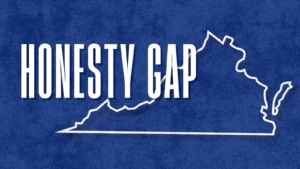
20 Mar An obtuse angle on the honesty gap
By Dale Chu
 Virginia’s latest bid to raise academic standards took center stage at last month’s state board of education meeting, where policymakers debated the future of the state’s proficiency benchmarks. At the heart of this discussion is Virginia’s “honesty gap”—the misleadingly high proficiency rates reported on state exams compared to the more sobering results on the National Assessment of Educational Progress (NAEP). While there’s widespread recognition of the need for greater transparency in student achievement, not everyone sees the problem—or the solution—the same way.
Virginia’s latest bid to raise academic standards took center stage at last month’s state board of education meeting, where policymakers debated the future of the state’s proficiency benchmarks. At the heart of this discussion is Virginia’s “honesty gap”—the misleadingly high proficiency rates reported on state exams compared to the more sobering results on the National Assessment of Educational Progress (NAEP). While there’s widespread recognition of the need for greater transparency in student achievement, not everyone sees the problem—or the solution—the same way.
For years, Virginia’s Standards of Learning (SOL) assessments have set the bar too low, creating a false sense of student success. This is part of a broader national issue where many states, unwilling to confront the true scale of their educational challenges, have lowered expectations to avoid delivering bad news. The recent board meeting underscored that support for raising the SOL cut scores is nearly unanimous. The only real outlier was a lone board member whose resistance to the proposed changes reflects a narrow, and frankly unhelpful, view of what’s at stake.
This dissenting voice didn’t dispute the need to raise the bar, as some might have expected. Instead, she dismissed the honesty gap as a ‘communications tool,’ arguing that students could still perform well under the existing, lower cut scores. Perhaps, but why not be upfront with parents and students from the start? Without honest data, how can resources be targeted to the students most in need—a constituency that this board member claimed to advocate for?
This thinking—if it can be called that—is both shortsighted and perverse. By downplaying the honesty gap, it avoids confronting the real issue: a lack of transparency. If parents aren’t aware of the challenges their children face, how can they be part of the solution? This mindset fuels the disconnect between sky-high graduation rates and rampant college remediation, perpetuating the very problems transparency could help address.
Virginia currently reports that 72 percent of fourth graders are proficient in reading according to the SOL, but only 29 percent meet the proficiency standard on NAEP—a difference of 43 percentage points! The Youngkin administration, along with the board, has made it clear that addressing this discrepancy is critical. Yet, in a perplexing moment, the board member in question argued that there was “no research” linking cut scores with higher academic performance. Her myopia misses the forest for the trees. Raising the bar isn’t just about changing test scores; it’s about aligning states expectations with national standards and upholding the responsibility, as public servants, to provide clear and accurate information to students and families.
As my colleague Jim Cowen recently pointed out in Forbes, what this boils down to is states overcoming their reluctance to confront tough truths. Virginia is embracing the problem, not running from it—an act of courageous leadership that’s sorely needed across the nation. Meanwhile, most other states are content with manipulating their definitions of learning proficiency, widening not only the honesty gap but an urgency gap as well—one that ultimately comes at the expense of students’ futures.
Virginia’s Governor Glenn Youngkin and Secretary of Education Aimee Guidera have made it a priority to close the state’s honesty gap by aligning the state’s cut scores with higher national expectations. At the end of the day, raising the cut scores is the right move. As mom used to say, honesty is the best policy. Period.


Sorry, the comment form is closed at this time.